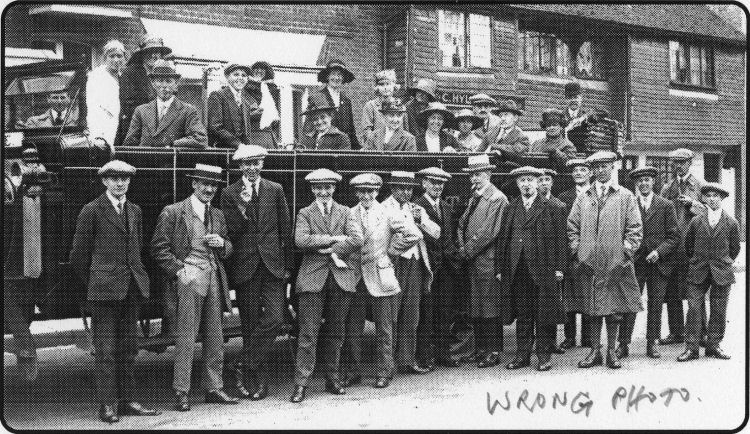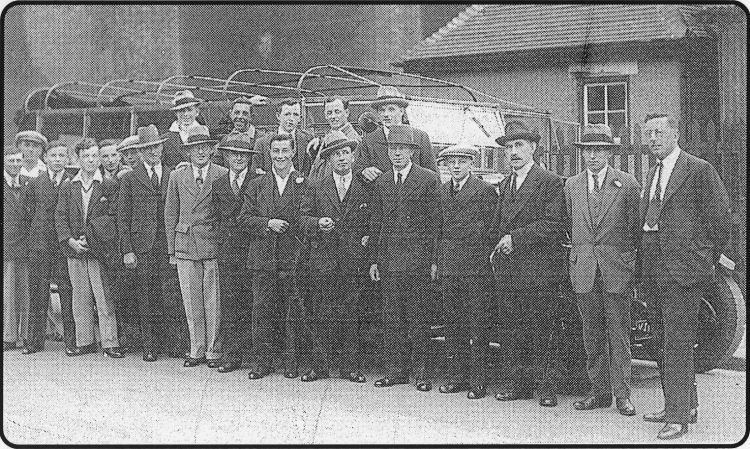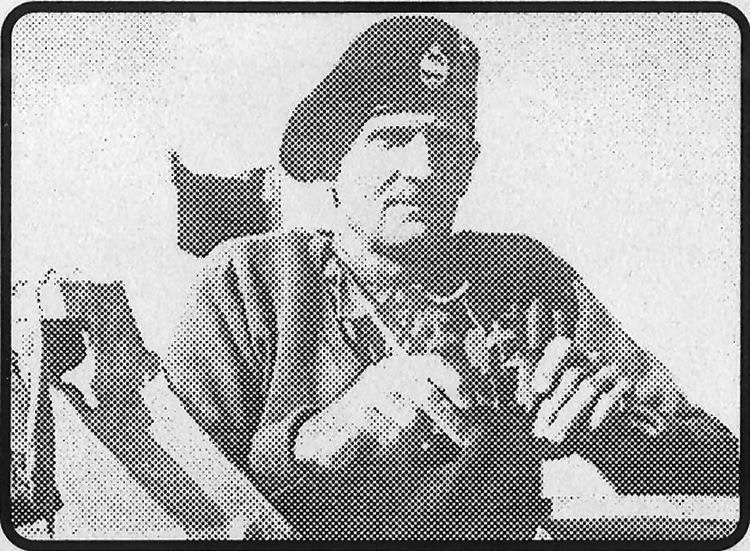
From the Folkestone Herald Published 2 March 2000
Beano trip!
WHOOPS! Sorry Alan Taylor and Bert Binfield, I seem to have dropped a
proverbial clanger and used the wrong picture in my Memories page, on
February 17 and I can’t blame my Mackintosh computer or printing problems -
only my poor memory.

I regret to say the photograph identified in the caption as a group of
workers of local builder F.W. Clark & Sons about to set off on an outing,
had nothing to do with that company.
One reader who was understandably puzzled was Ron Hammond, of Ernwell Road,
Folkestone who began working for the company as a boy in 1929 at six
shillings (30p) a week!
He thought perhaps I had been shown a picture taken before his time. In fact
Ron produced a copy of the same photograph that Bert Binfield had shown
local historian Alan Taylor - the one I had scanned into the computer system
weeks ago
- and apparently lost.
So, thanks very much Ron!
Ron was also able to give me nearly all the names of the 21 people in this
photo and, what’s more, he was able to give the jobs they did
into the bargain!
Ron was also able to tell me: “You may take note Bert Binfield’s father,
Horace, is on this photograph.
“He taught me a lot about the art of bricklaying,” Ron told me.
The picture dates from 1931 and the ‘Beano’ outing party he says, was headed
for the sights of London.
Open top.

‘Monty’ Second World War hero of the desert war in North Africa who is
pictured at El Alamein only weeks after speaking to army officers about the
fight ahead in which Rommel's tanks were defeated.
Pictured outside Folkestone Corporation yard in Bradstone Road, in 1931
before setting out on an outing to London are members of the staff of
builders F.W. Clark & Sons, whose business was based at the Viaduct, also in
Bradstone Road.
The Rodwell’s open-top coach or charabanc, with folding hood, is almost
completely hidden by the merry makers who are pictured standing outside
Folkestone Corporation’s weighbridge office which was in Bradstone Road. It
stood opposite the firm’s works.
One man is missing off the left hand end of Ron’s copy of the picture
compared with Mr Binfield’s. Perhaps he was the bus driver.
In the front row, from left
to right, are Mr Southern, a guest; Steve Look, a labourer whose father,
says Ron, had a boatyard down in Harbour Street; Ernie Southern, a young
labourer; Fred Knott, a guest who was a pal of Ron’s.
Sadly he was killed while serving on a destroyer in Dover Harbour. His
father had a general store in Dover Street.
Next was Frank Reed, an office worker; then Frank Biscoe, a carpenter whose
father was a bricklayer of the same name; Dick Couglan, plumber who later
worked for Woolworths and was in the St John Ambulance; Bert Savage, painter
whose father was a fireman; Bill Boorman, painter who later became
self-employed; Walter Williams, plasterer who had several brothers; Owen
Maguire, painter, from Cheriton; Bill Withey, foreman plumber, who lived
in Greenfield Road and had worked on aircraft during the First World War.
Next comes Percy Mount, carpenter’s apprentice who lived in the miller’s
house behind the Salvation Army premises; Horace Binfield, bricklayer, of
Blackbull Road, who was Bert Binfield’s father; Les Worsley, joiner shop
foreman, who lived in Garden Road; and on the right hand end is Councillor
Alfred J. S. Clark, the firm’s ‘governor,’ who lived at 28 Chart Road and
later in Manor Road.
Left to right in the back row are Ernest Hogben, painter apprentice, who
lived in Rossendale Road; next is Ron Hammond himself who, as an apprentice
bricklayer lived in Mount Pleasant Road; Jack Prior, a painter, also of
Mount Pleasant Road; Alf Porter, painter, from
Cheriton; and finally, Bob Clark, foreman painter and the man who organised
the outing!

'Monty' Second World War hero of the desert was in North Africa who is
pictured at El Alamein only weeks after speaking to army officers about the
fight ahead in which Rommel's tanks were destroyed.
Next week in Memories I intend to return to the subject of another local
firm of builders, Otto Marx and a big contract they won to build the old
Astoria (Odeon) Cinema - and a secret wartime meeting held there by that
‘Desert Rats’ hero General Bernard Montgomery.
 |
|
1900
Ruskin’s good and bad memories of old town.
PAPERS commented on the Folkestone connections since
boyhood of John Ruskin, the academic and artist who died in January
1900. He once bought a collection of pictures of old Folkestone In a
local auction, but when it was suggested he might present them to the
town when “they had served his purpose” he briskly replied in a letter
he could only reply that, as Folkestone had sold all that was left of
Old Folkestone “to the service of Old Nick” - the South Eastern Railway
- which charged him a penny every time he went to take a look at the
town from the old pier and blotted the view with smoke and steam, he was
“not Inclined to present the town with any peeps and memories of the
shore it had destroyed or the harbour It had filled and polluted.” They
were bought, he said, to Illustrate Turner's work and his own on the
harbours of England and would, he hoped, be put to wider service than
they were likely to find In Folkestone Museum. Fortunately a second
consignment of pictures (the source not quoted in either case) was
bought by an Arthur Tite who allowed John English to use some in his
popular book Old Folkestone Smugglers and Smuggling Days.
|
|
1925
Elham Valley line pressed in to use as main line blocked.
THERE was an overwhelming vote at a public meeting against the
go-ahead being given for a bandstand In front of the Leas Cliff Hall.
The report of the meeting took up three columns of the Herald. A number
of councillors were on the platform. A landslide blocked the main
Ashford to Folkestone railway line near Smeeth station and It required a
team of a hundred men to clear the line. The rails were forced out of
position and trains had to be diverted, some via Chatham, Faversham and
Canterbury and the old Elham Valley Railway. Mr H Selby Lowndes, 52, was
celebrating his 25 years as Master of the East Kent Hunt and was
honoured by a dance at the Grand Hotel. His father, grandfather and
great-grandfather In turn had held the mastership of the Whaddon Chase
hunt for about 200 years. If there was a lobby against fox hunting 75
years ago It must have come as a shock to members to learn a consignment
of three dozen foxes had arrived In the UK from Canada. The story made
headlines all over the UK. But these were silver black foxes for
breeding for the fur trade, the nearest such being at Bexhill. Writer
Felix was reflecting on the fact British beef farmers could not satisfy
public demand as economically as Importers of carcases of beef from
thousands of miles across the Atlantic.
|
|
1950
Ban the H-bomb - that was election call in 1950.
“WORLD Must Ban the H-Bomb” that
was one of the headlines on a page of our old midweek paper, the
Folkestone & Hythe Gazette, featuring the speeches of local general
election candidates. Another subject of debate was Labour's case for
nationalisation of Industry, while a Tory 'pledge' was more pay and
better conditions for regular service men and women so that eventually
peacetime conscription could be abolished. A mine disaster that killed
two coastguards at Sandgate 80 years ago, in November 1920, was recalled
by the Gazette. The drifting French mine was secured to the rail of
steps leading to the beach from the Parade so It would not be dashed
against the wall by heavy seas. Leading boatman William Walker, 38,
survivor of the blowing up of the battleship HMS Ocean, had started work
on the mine, which was of a type he was not familiar with, when it
exploded killing him and Coastguardsman James McDermott who had been
guarding It. Many surrounding properties were also damaged, from Encombe
Dwellings to Devonshire Terrace, as ceilings were brought down and
furniture smashed. Months of legal battles followed to get the
Government to accept responsibility for compensation for the many
thousands of pounds worth of damage. Why didn’t they call In an expert
|
|
1975
Decision imminent on £40 million port marina plan.
WE DON'T want men as midwives. - That was the message from
the nursing profession locally as there was talk of new legislation to
allow men to train in midwifery. There were plans at the same time for
midwifery training at Willesboro’ Hospital. 6,000 people on the local
council’s waiting list for homes were not happy at the revelation that
one in 20 of the houses In the area were empty and not contributing to
rates. That figure did not Include holiday or weekend homes, or larger
properties In which only one bedroom was in use. The Council’s plans
sub-committee declined to use Its powers to make a decision on local
businessman Sidney de Haan's £40m marina plan announced 11 months before
for a site at Copt Point Briefly the plans included hotel accommodation
with 3,000 beds, a conference centre for 1,200 delegates, a non-tidal
marina with locks and 200 rentable mariners' apartments, casino and
restaurant, health resort with 150 beds, underground parking for at
least 1,500 cars and an advanced sewage treatment scheme. Objectors
included Trinity House Pilotage Service, British Rail (concerned about
sea defences), the Countryside Commission (worried about destruction of
natural beauty), a local yacht and boat club and Kent Trust for Nature
Conservancy (concerned about the Warren site of scientific interest.)
Support came from the Committee for the Protection of Rural Kent.
|
|




